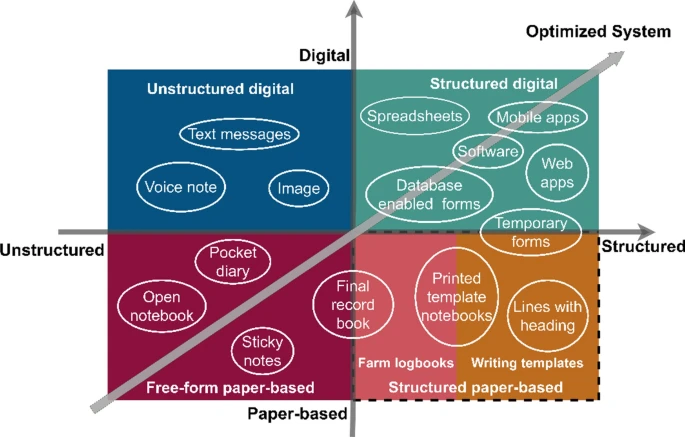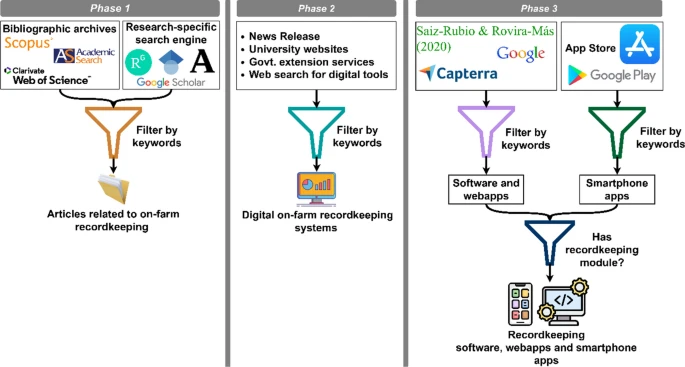In the present era of agricultural digitalization, documenting on-farm operations is critical. These records contextualize other layers of data and underpin economic analysis and informed decision-making. On-farm recordkeeping is rooted in an ancient tradition and has evolved from pen and paper to digital means integrating diverse tools and methods. These tools vary widely in mode of data recording and this presents challenges in achieving complete, accurate and interoperable data. Assessing this diversity of existing recordkeeping systems is a key step toward the improvement in recordkeeping systems that enhance data quality and interoperability. Despite the importance, as of present, comprehensive studies addressing this challenge are lacking. A systematic review of existing on-farm recordkeeping systems was carried out to address their advantages and weaknesses and to analyze their features and traits, focusing on interoperability and adherence to efficient and comprehensive on-farm recordkeeping. Paper-based recordkeeping, a longstanding and reliable method, is gradually being replaced by digital platforms. Many universities and agencies have released farm management spreadsheets and interactive database forms representing the initial step toward intuitive recordkeeping. Furthermore, farm management software, web apps, and user-friendly smartphone apps are increasingly crucial for handling agricultural big data. Notably, among the surveyed software packages and apps, most of them are not free and only a few support data interoperability. The survey also indicates a scope for further development in open-source tools with automation in recordkeeping. Adopting digital on-farm recordkeeping tools can positively impact both on and off the farm, fostering data interoperability, controlled yet flexible data access, completeness, and appropriate accuracy.
Full publication at: https://link.springer.com/article/10.1007/s11119-024-10172-7

Figure 1 depicts a transition from unstructured to structured method of recordkeeping and concurrently a similar trend of transition from paper-based to digital. The takeaways from Fig. 1 include:
An apparent shift from paper-based to digital recordkeeping methods Digital recordkeeping systems have advantages over paper-based systems in terms of ease in query, retrieval, transfer, and interoperability. These reasons encourage a transition from paper-based to digital recordkeeping systems that will likely persist into the future. To effectively navigate this transition, farmers and agricultural workers must have a readiness to embrace digitalization. It is imperative to provide them with appropriate education and resources to facilitate their adaptation to digital recordkeeping practices.
The transition from unstructured to structured recordkeeping poses challenges While unstructured methods offer convenience in field data collection, they make data retrieval more difficult than with structured methods. There is a growing trend towards structured means for long-term data storage alongside the continued use of unstructured recordkeeping systems, which anticipates a coexistence of both systems in the future. To address both systems’ efficacy, developers should emphasize tools with improved user-friendliness and accessibility. Collaborating between farm stakeholders, educators, and developers is imperative to understand their specific needs and develop tailored solutions.
Farm recordkeeping is moving toward an optimized system Digital recordkeeping outperforms paper-based systems, but unstructured and structured methods persist for their unique advantages. Ideally, the trend of on-farm recordkeeping will move toward a digital system having the ease of unstructured systems yet the advantages of structured methods. Engagement from farm stakeholders (who are related to farm work, i.e., workers, managers etc.) is essential to facilitate the transition to advanced digital technologies. Providing training and educational resources to facilitate technology adoption is imperative, with universities and extension agencies positioned to play a pivotal role. Additionally, being pivotal actors in this domain, software developers should endeavor to devise more robust and user-friendly digital tools that integrate the simplicity of unstructured methods with the efficacy of structured recordkeeping.


